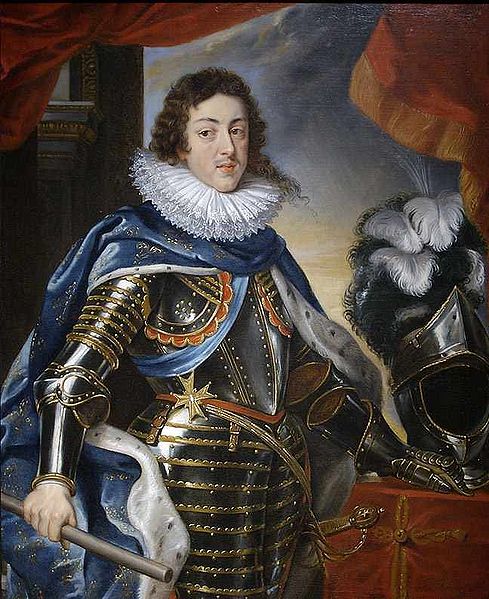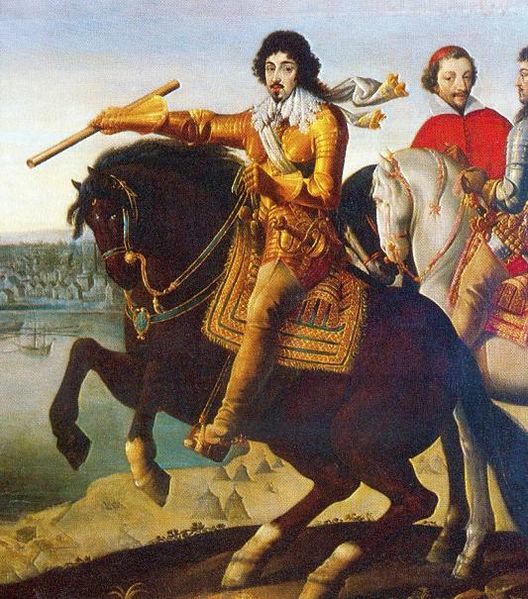<Back to Index>
- Mathematician Gaston Tarry, 1843
- Composer Giovanni Carlo Maria Clari, 1677
- King of France and Navarre Louis XIII, 1601
PAGE SPONSOR
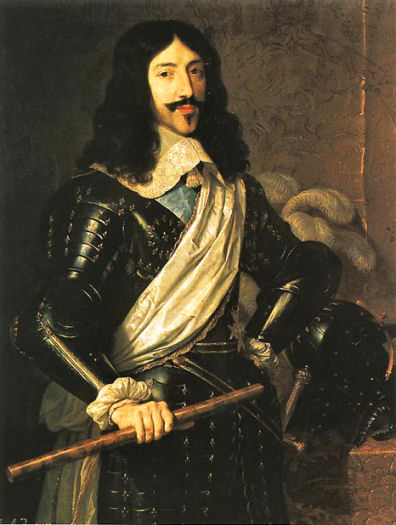
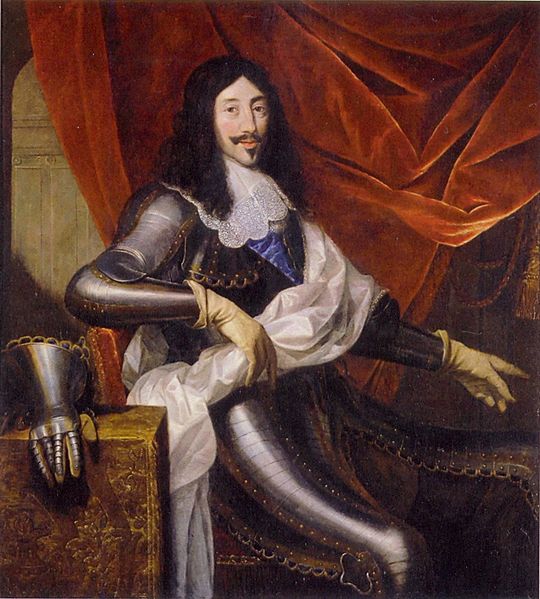
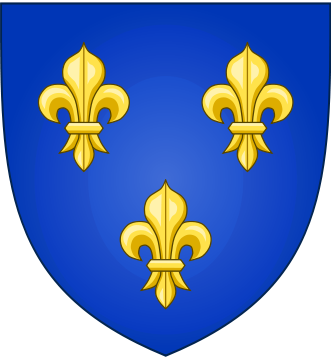
Louis XIII (27 September 1601 – 14 May 1643) was King of France and Navarre from 1610 to 1643. Along with his First Minister Cardinal Richelieu, Louis "the Just" is remembered for the establishment of the Académie française and participation in the Thirty Years' War against the House of Habsburg. France's greatest victory in the war came at the Battle of Rocroi, five days after Louis's death — apparently from complications of intestinal tuberculosis, "marking the end of Spain's military ascendancy in Europe."
Born at the Château de Fontainebleau, Louis XIII was the eldest child of Henry IV of France (1553 – 1610) and Marie de' Medici (1575 – 1642). As son of the King, he was a Fils de France, and as the eldest son, the Dauphin. His father was the first Bourbon King of France, having succeeded his ninth cousin, Henry III of France (1574 – 1589), in application of Salic law. Louis XIII's paternal grandparents were Antoine de Bourbon, duc de Vendôme and Jeanne d'Albret, Queen of Navarre; his maternal grandparents were Francesco I de' Medici, Grand Duke of Tuscany, and Johanna, archduchess of Austria, and Eleonora de' Medici, his maternal aunt, was his godmother.
James I’s ambassador to Paris, Edward Herbert, 1st Baron Herbert of Cherbury, who presented his credentials to Louis XIII in 1619, remarked on Louis’ extreme congenital speech impediment, and his double teeth:
Louis XIII ascended to the throne in 1610 in Rue des Grands Augustins, at the age of eight - and - a - half, upon the assassination of his father. His mother, Marie de' Medici, acted as Regent until Louis XIII came of age at thirteen. Marie maintained most of her husband's ministers, with the exception of Maximilien de Béthune, duc de Sully, who was unpopular in the country. She mainly relied on Nicolas de Neufville, seigneur de Villeroy, Noël Brûlart de Sillery, and Pierre Jeannin. Marie pursued a moderate policy, confirming the Edict of Nantes. She was not, however, able to prevent rebellion by nobles like Henry II de Bourbon, prince de Condé, the next - in - line to the throne. Condé did squabble with Marie in 1614, briefly raising an army, but he received little support, and Marie was able to raise her own army. Nevertheless, Marie agreed to call an Estates General assembly to address Condé's grievances....I presented to the King [Louis] a letter of credence from the King [James] my master: the king [Louis] assured me of a reciprocal affection to the king [James] my master, and of my particular welcome to his Court: his words were never many, as being so extream [sic] a stutterer that he would sometimes hold his tongue out of his mouth a good while before he could speak so much as one word; he had besides a double row of teeth, and was observed seldom or never to spit or blow his nose, or to sweat much, 'tho he were very laborious, and almost indefatigable in his exercises of hunting and hawking, to which he was much addicted...
This Estates General assembly was delayed until Louis XIII formally came of age on his thirteenth birthday. Although Louis's coming of age formally ended Marie's Regency, she remained the de facto ruler of France. The Estates General accomplished little, spending its time discussing the relationship of France to the Papacy and the venality of offices, but not reaching any resolutions.
Beginning in 1615, Marie came to rely increasingly on Concino Concini, who now assumed the role of her favourite. Concini was widely unpopular because he was an Italian, and therefore a foreigner. This further antagonised Condé, who launched another rebellion in 1616. Huguenot leaders supported Condé's rebellion, which led the young Louis XIII to conclude that they would never be loyal subjects. Eventually, Condé and Queen Marie made peace via the Treaty of Loudun, which allowed Condé great power in government, but didn't remove Concini. With growing dissatisfaction from nobles due to Concini's position, Queen Marie, with Louis' help, imprisoned Condé to protect Concini, leading to renewed revolts against the Queen and Concini.
In the meantime, Charles d'Albert, the Grand Falconer of France,
convinced Louis XIII that he should break with his mother and support
the rebels. Louis thus organised a palace coup d'état. As a
result, Concino Concini was assassinated (24 April 1617) and Marie was sent into exile in Blois. Louis created Charles d'Albert, his new favourite, the first duke of Luynes. Luynes
soon became as unpopular as Concini had been. Other nobles resented
what they saw as Luynes's monopolisation of the King. Luynes was seen
as not as competent as Henry IV's ministers, who had surrounded Marie
de' Medici, and who were now dying off. The Thirty Years' War broke
out in 1618. The French Court was initially unsure what side to
support. On the one hand, France's traditional rivalry with the House of Habsburg argued in favour of intervening on behalf of the Protestant powers (and Louis's father Henry IV of France was
once a Huguenot leader). On the other hand, Louis XIII had had a strict
religious Catholic upbringing, and his natural inclination was
therefore to support the Catholic Holy Roman Emperor, Ferdinand II. The French nobles were further antagonised against Luynes by the 1618 revocation of the paulette tax and
by the sale of offices in 1620. From her exile in Blois, Marie de'
Medici became the obvious rallying point for this discontent, and the bishop of Luçon was allowed to act as her chief adviser, serving as a go-between to Marie and the King. French nobles launched a rebellion in 1620, but their forces were easily routed by royal forces at Les Ponts - de - Cé in August 1620. Louis then launched an expedition against the Huguenots of Béarn who
had defied a number of Royal decisions. This expedition managed to
re-establish Catholicism in Béarn. However, the Béarn
expedition drove Huguenots in other provinces into a rebellion led by Henri, duc de Rohan. In 1621, Louis XIII was formally reconciled with his mother. De Luynes was created Constable of France and Louis and Luynes set out to quell the Huguenot rebellion. The siege at the Huguenot stronghold of Montauban had
to be abandoned after three months, owing to the large number of Royal
troops who had succumbed to camp fever. One of the victims of camp
fever was Luynes, who died in December 1621. Following
the death of Luynes, Louis determined that he would rule by council.
His mother returned from exile and, in 1622, entered this council where Henry II de Bourbon, prince de Condé recommended
violent suppression of the Huguenots. The 1622 campaign, however,
followed the pattern of the previous year: Royal forces won some early
victories, but were unable to complete a siege, this time at the
fortress of Montpellier. The rebellion was ended by the Treaty of Montpellier, signed by Louis XIII and Henri, duc de Rohan, in October 1622. The treaty confirmed the tenets of the Edict of Nantes: several Huguenot fortresses were to be razed, but the Huguenots retained control of Montauban and La Rochelle. Louis ultimately dismissed Noël Brûlart de Sillery and Pierre Brulart, vicomte de Puisieux, in 1624 because of his displeasure with how they handled the diplomatic situation over the Valtellina with Spain. Valtellina was an area with Catholic inhabitants under the suzerainty of the Protestant Three Leagues.
It served as an important route to Italy for France and also it
provided an easy connection between the Spanish and the Austrian
Habsburg Kingdoms, especially in helping each others with armies if
necessary. Spain was constantly interfering in the Valtellina, which
angered Louis as he wanted to hold possession of this strategically
important passageway. (At these years the French Kingdom was literally
surrounded by the Habsburgs as they were the Kings of Spain and
Austria. In addition, these empires included the territories of today's
Belgium, the Netherlands, parts of Germany and Northern Italy.) Cardinal Richelieu played
a major role in Louis XIII's reign from 1624, decisively shaping the
destiny of France for the next eighteen years. As a result of
Richelieu's work, Louis XIII became one of the first examples of an absolute monarch. Under Louis and Richelieu, the crown successfully intervened in the Thirty Years' War against the Habsburgs, managed to keep the French nobility in line, and retracted the political and military privileges granted to the Huguenots by Henry IV (while maintaining their religious freedoms). Louis XIII led successfully the important Siege of La Rochelle. In addition, Louis had the port of Le Havre modernised, and he built a powerful navy. Unfortunately, time and circumstances never
permitted the King and the Cardinal to attend to the administrative
reforms (particularly of France's tax system) which were urgently
needed. Louis
also worked to reverse the trend of promising French artists leaving
for Italy to work and study. He commissioned the painters Nicolas Poussin and Philippe de Champaigne to decorate the Louvre. In foreign matters, Louis organised the development and administration of New France, expanding its settlements westward along the Saint Lawrence River from Quebec City to Montreal. In order to continue the exploration efforts of his predecessor Henry IV, Louis XIII considered a colonial venture in Morocco, and sent a fleet under Isaac de Razilly in 1619. Razilly was able to reconnoiter the coast as far as Mogador. In 1624, he was put in charge of an embassy to the pirate harbour of Salé in Morocco, in order to solve the affair of the library of Mulay Zidan. In
1630, Razilly was able to negotiate the purchase of French slaves from
the Moroccans. He visited Marocco again in 1631, and participated to
the negotiation of the Franco - Moroccan Treaty (1631). The Treaty gave France preferential treatment, known as Capitulations: preferential tariffs, the establishment of a Consulate and freedom of religion for French subjects.
Acadia was also developed under Louis XIII. In 1632, Isaac de Razilly became involved, at the request of Cardinal Richelieu, in the colonization of Acadia, by taking possession of the Habitation at Port - Royal (now Annapolis Royal, Nova Scotia) and developing it into a French colony. The King gave Razilly the official title of lieutenant - general for New France. He took on military tasks such as ordering the taking of control of Fort Pentagouet at Majabigwaduce on the Penobscot Bay,
which had been given to France in an earlier Treaty, and to inform the
English they were to vacate all lands North of Pemaquid. This resulted in all the French interests in Acadia being restored. In Brazil, the colony of Equinoctial France was established in 1612, but only lasted 4 years until it was eliminated by the Portuguese. France - Japan relations started under Louis XIII in 1615 when Hasekura Tsunenaga, a Japanese samurai and ambassador, sent to Rome by Date Masamune, landed at Saint - Tropez for a few days. In 1636, Guillaume Courtet, a French Dominican priest, would reciprocate when he set foot in Japan. The same year, in 1615, the regent Marie de Médici incorporated the merchants of Dieppe and other harbours to found the Company of the Moluccas.
In 1619, an armed expedition composed of three ships (275 crews, 106
cannons) and called the "Fleet of Montmorency" under General Augustin de Beaulieu was sent from Honfleur, with the objective of fighting the Dutch in the Far East. Finally in 1624, with the Treaty of Compiègne, Richelieu obtained that the Dutch would stop fighting the French in the East.
On two occasions the King's younger brother,
Gaston, Duke of Orléans had
to leave France for conspiring against the King's government, and for
attempting to undermine the influence of both his mother and of Cardinal Richelieu. After waging an unsuccessful war in Languedoc, he took refuge in Flanders.
In 1643, on the death of Louis XIII, Gaston became lieutenant - general
of the kingdom, and fought against Spain on the northern frontiers of
France. On 24 November 1615, Louis XIII married Anne of Austria, daughter of Philip III of Spain.
This marriage followed a tradition of cementing military and political
alliances between the Catholic powers of France and Spain with Royal
marriages. The tradition went back to the marriage of Philip II of Spain with the French Princess, Elisabeth of Valois.
The marriage was only briefly happy, and the King's duties often kept
them apart. After twenty - three years of marriage and four miscarriages,
Anne finally gave birth to a son on 5 September 1638, the future Louis XIV. Many regarded
this birth as a divine miracle and, in show of gratitude to God for the
long awaited birth of an heir, his parents named him Louis - Dieudonné (“God - given”).
As another sign of gratitude, according to several interpretations,
seven months before his birth, France was dedicated by Louis XIII to the Virgin Mary, who, many believed, had interceded for the perceived miracle. However,
the text of the dedication does not mention the royal pregnancy and
birth as one of its reasons. Also, Louis XIII himself is said to have
expressed his scepticism with regards to the miracle after his son's
birth. In gratitude for successfully given birth the queen founded the Benedictine abbey of the Val - de - Grâce, for which the Louis XIV himself laid the cornerstone of its church, an early masterpiece of French Baroque architecture. It
is said that when the king lay on his deathbed the queen brought Louis
(who was not yet five years old) to see his father. The young Louis
could already grasp the reality of the situation because when his
father asked his son if he knew who he was, the young Louis answered,
"Louis the Fourteenth, Father." To which his father responded, "You are
not Louis the Fourteenth, yet."
There is no evidence that Louis had mistresses (consequently earning the title of 'Louis the Chaste'), but persistent rumours insinuated that he may have been homosexual or at least bisexual. Tallemant des Réaux, drawing from rumours told to him by a critic of the king (the marquise de Rambouillet), explicitly speculated in his Historiettes what happened in the King's bed. A liaison with an equerry,
François de Baradas, ended when the latter lost favour fighting
a duel after duelling had been forbidden by royal decree. He was also allegedly captivated by Marquis de Cinq-Mars,
who was later executed for conspiring with the Spanish enemy in time of
war. Tallemant described how on a Royal journey, the King "sent M. le
Grand [de Cinq-Mars] to undress, who returned, adorned like a bride.
'To bed, to bed' he said to him impatiently... and the mignon was not
in before the King was already kissing his hands."

